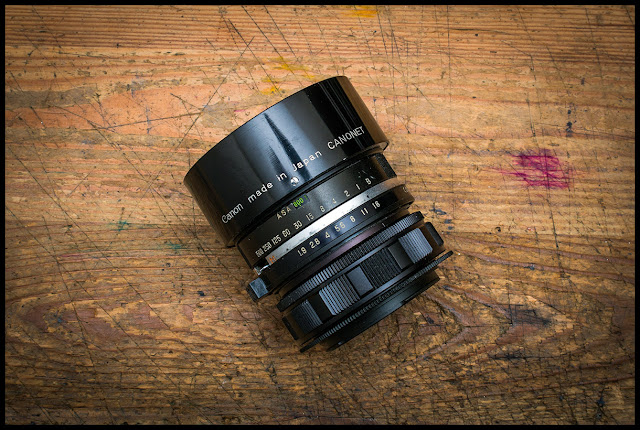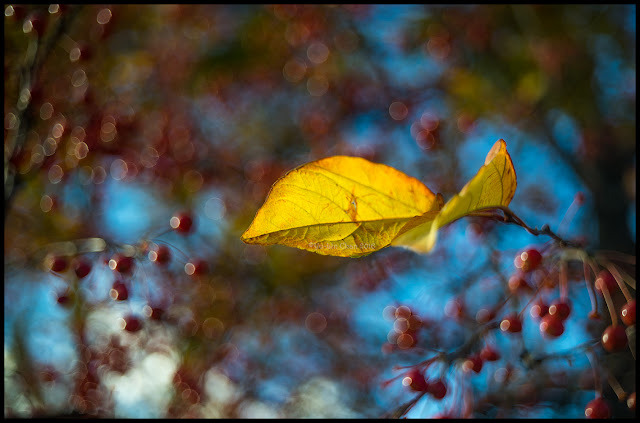I know a lot of people just could not understand why anyone would even bother with a standard lens having an f3.5 maximum aperture. Today's modern 50mm lens of f1.8 is considered slow. So yes, why bother?
All I can say is that each lens has its place, and justification for its existence. f3.5 is slow for low light photography, but there are many places where it can still make wonderful photographs, and you often find the photos they render is not reproducible by modern lenses. The Minolta Chyoko 4.5cm f3.5 is one slow lens that I really, really like.
Minolta "A" in its original form. Note the round design. Very hard to hold and use.
This lens came from the
Minolta "A" rangefinder, introduced in 1955 as an entry level rangefinder. I have never held a more un-ergonomical camera than this one. I think the design is terrible. The camera feels like a melon in my hands, but we are only interested in the lens, so it's ergonomics is inconsequential. The lens came out quite easily from the camera with just a few screws from the front of the camera.
Lens is very easy to remove. in fact, the lens can be removed without touching much of the camera body.
Lens as it came out of the camera. Note the shutter mechanism at the rear of the lens. Since we don't need it, it can be easily removed, and the best part of this, is that you don't have to worry about keeping the shutter open like most rangefinders with shutter assembly built into the lens.
The focus mechanism of this lens had very little damping so I decided to disassemble the lens to clean it and re-lube it. To do that, the front group of elements need to be unscrewed, but do be careful when removing it; this lens group is used to secure the aperture mechanism. I made a mistake of tilting the lens while removing the lens group and the aperture assembly came out of its place. Took me a long time to put the blades back.
Front lens group removed. Note the aperture blades are just sitting there without anything else to second it in place. The lens group is the only thing keeps it secured. Don't tilt the lens while removing the lens group, otherwise prepare to spend a lot of time trying to put them back.
All the parts of the lens disassembled. It's quite easy and simple. Just remove all screws, but don't lose any screws and remember the sequence.
The disassembly of the lens is quite easy by removing the screws. Be sure to note where the specific screws go and don't lose any. The only tricky part, is putting the helicoid back. You DO need to put the parts back at the specific location or the distance scale will not line up. I usually mark where the parts separate, and this will help later. Otherwise, you will have a lot of trial and errors and this is not a fun thing to do, believe me.
After the helicoid is taken apart, I used Ronsonol lighter fluid on a Q-Tip to clean off the old grease, and re-apply a light grease. In a future post, I will talk about the different greases I tried and why I ended up with what I am using, which is
Slickoleum Light Grease, that I also use for my bicycles chain and other parts. This grease is light and provides the right amount of damping than the others I have tried.
Once the lens is cleaned and reassembled, the next part is the machine a spacer between the lens and the Pentax focus helicoid, which will act as part of the spacer between the lens and the Sony E-Mount. With a lathe, this was very easy to do, especially when I decided to just glue the parts together, instead of drilling and tapping screw holds and use screws to hold them.
Simple parts required: on the left is a mount from an M42 2x teleconverter which I cut out. Middle is the spacer I machined from aluminium. The M42 mount will be glued to the top of this part. What's not shown is the rough marks I make on the surface to make the glue adhere better. On the right, of course is the lens.
The other side of the parts. Note the screw holes on the lens. If I wanted to, I can drill and tap the spacer and screw them together, but I find glue is strong enough. I am still having trouble getting perfect alignment for screw holes. I need a drill press, which I don't have, to do this properly.
This lens has a rather long flange distance. At first I thought it could be used on my Nikon D810, but no dice; it's still shorter than the very long F-Mount flange. However, the distance allows the Pentax focus helicoid to be used as part of the space between the lens and the E-Mount, but just barely.
Minolta Chyoko 4.5cm f3.5 mounted on the Pentax Focus Helicoid and then on the Sony A7. The lens itself has a focus mechanism, and can be used for medium to infinity focus. For close up, I use the focus helicoid, or a combination of the two, for extremely close up.
In part II, we will take a look at what the lens can do. You already had a peek from the picture in the last post, showing it's interesting bokeh. We will explore more next time.




















































